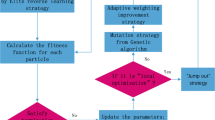Abstract
Armored vehicle design is a complex constrained optimization problem which often involves a number of fuzzy and stochastic parameters. In this paper, a fuzzy optimization problem model of armored vehicle scheme design is presented, and a new particle swarm optimization (PSO) algorithm is proposed for effectively solving the problem. The problem model uses fuzzy variables to evaluate the objective function and constraints of the problem. The algorithm employs multiple ranking criteria to define three global bests of the swarm, makes different quality particles learning from different global bests, and thus search effectively through the solution space by means of multi-criteria optimization. Experiment results show that our approach can achieve good solution quality with low computational costs.





Similar content being viewed by others
References
Zadeh LA (1978) Fuzzy sets as a basis for a theory of possibility. Fuzzy Sets Syst 1(1):3–28
Kennedy J, Eberhart R (1995) Particle swarm optimization. In: Proceedings of IEEE international conference on neural networks, Perth WA, Australia, pp 1942–1948
Li XD, Engelbrecht AP (2007) Particle swarm optimization: an introduction and its recent developments. In: Proceedings of 2007 genetic and evolutionary computation conference, London, England, pp 3391–3414
Yang RJ, Gu L, Tho CH, Choi KK, Youn BD (2002) Reliability-based multidisciplinary design optimization of a full vehicle system. In: Proceedings of 43rd AIAA SDM conference, Denver, USA, pp 1–9
Kodiyalam S, Yang RJ, Gu L, Tho CH (2004) Multidisciplinary design optimization of a vehicle system in a scalable, high performance computing environment. Struct Multidiscip Optim 26(3–4):256–263
Tušar T, Korošec P, Papa G, Filipič B, Šilc J (2007) A comparative study of stochastic optimization methods in electric motor design. Appl Intell 27(2):101–111
Nosratollahi M, Mortazavi M, Adami A, Hosseini M (2010) Multidisciplinary design optimization of a reentry vehicle using genetic algorithm. Aircraft Eng Aerospace Technol 82(3):194–203
Ebrahimi M, Farmani MR, Roshanian J (2011) Multidisciplinary design of a small satellite launch vehicle using particle swarm optimization. Struct Multidiscip Optim. doi:10.1007/s00158-011-0662-7
Fang W, Shi R (2003) Pareto genetic algorithms for multi-objective optimization of aircraft conceptual design. J Beijing Univ Aeronaut Astronaut 29(8):668–672
Adra SF, Hamody AI, Griffin I, Fleming PJ (2005) A hybrid multi-objective evolutionary algorithm using an inverse neural network for aircraft control system design. In: Proceedings of 2005 IEEE congress on evolutionary computation, Edinburgh, Scotland, pp 1–8
Hu TY, Yu XQ (2009) Aerodynamic/stealthy/structural multidisciplinary design optimization of unmanned combat air vehicle. Chin J Aeronaut 22(4):380–386
García-Pedrajas N, Herrera F, Fyfe C (2011) Special issue on the trends in applied intelligence systems. Appl Intell 34(3):329–330
Khan SA, Engelbrecht AP (2012) A fuzzy particle swarm optimization algorithm for computer communication network topology design. Appl Intell 36(1):161–177
Norouzzadeh MS, Ahmadzadeh MR, Palhang M (2011) LADPSO: using fuzzy logic to conduct PSO algorithm. Appl Intell. doi:10.1007/s10489-011-0328-6
Song B, Xu D, Zhang Y (1999) Multiobjective fuzzy weight-optimization design of under-water vehicle shell structure. J Northwestern Polytech Univ 17(2):274–279
Zhang Y, Gao S, Li L, Chen L, Yang J, Abdel-Malek K (2007) A fuzzy synthesis control scheme and optimization for vehicle dynamic stability system. In: Proceedings of the ASME international design engineering technical conferences and computers and information in engineering conference, Las Vegas, NV, vol 5, pp 1959–1965
Tang C, Zhao L (2010) Fuzzy optimization of vehicle power train based on dynamic quality and fuel economy. In: Proceedings of the 2nd international conference on mechanical and electronics engineering, Kyoto, Japan, vol 2, pp 2390–2393
Tang JF, Wang DW, Fung YK, Yung KL (2004) Understanding of fuzzy optimization: theories and methods. J Syst Sci Complex 17(1):117–136
Cheng CH (1998) A new approach for ranking fuzzy numbers by distance method. Fuzzy Sets Syst 95(3):307–317
Liu B, Liu YK (2002) Expected value of fuzzy variable and fuzzy expected value models. IEEE Trans Fuzzy Syst 10(4):445–450
Chen SJ, Chen SM (2007) Fuzzy risk analysis based on the ranking of generalized trapezoidal fuzzy numbers. Appl Intell 26(1):1–11
Ramli N, Mohamad D (2009) A comparative analysis of centroid methods in ranking fuzzy numbers. Eur J Sci Res 28(3):492–501
Inuiguchi M, Greco S, Slowinski R, Tanino T (2003) Possibility and necessity measure specification using modifiers for decision making under fuzziness. Fuzzy Sets Syst 137(1):151–175
Prodanovic P, Simonovic SP (2003) Fuzzy compromise programming for group decision making. IEEE Trans Syst Man Cybern, Part A, Syst Hum 33(1):358–365
Liu B (2007) Uncertainty theory, 2nd edn. Springer, Berlin
Zheng YJ (2010) Extended tabu search on fuzzy traveling salesman problem in multi-criteria analysis. In: Proceedings of the 6th international conference on algorithmic aspects in information and management. Lecture notes in computer science, vol 6124. Springer, Berlin, pp 314–324
Zheng YJ, Ling HF, Chen SY (2012) Fuzzy combinatorial optimization with multiple ranking criteria: a staged tabu search framework. Pacific J Optim (in press)
Jiao B, Zheng YJ, Zhang ZQ (2001) Exponential regression model for operation and support cost of armored vehicle. J Armored Force Eng Inst 15(3):22–27
Ho SJ, Ku WY, Jou JW, Hung MH, Ho SY (2006) Intelligent particle swarm optimization in multi-objective problems. In: Proceedings of 10th Pacific-Asia conference on knowledge discovery & data mining. Lecture notes in artificial intelligence, vol 3918. Springer, Berlin, pp 790–800
Deb K, Pratap A, Agarwal S, Meyarivan T (2002) A fast and elitist multi-objective genetic algorithm: NSGA-II. IEEE Trans Evol Comput 6(2):182–197
Zitzler E, Deb K, Thiele L (2000) Comparison of multiobjective evolutionary algorithms: empirical results. Evol Comput 8(2):173–195
Acknowledgements
This work was supported in part by grants from National Natural Science Foundation (Grant No. 61105073, 61020106009) of China. The authors are grateful to the data provided by Institute of Armored Forces Equipment and Technology.
Author information
Authors and Affiliations
Corresponding author
Rights and permissions
About this article
Cite this article
Wang, K., Zheng, Y.J. A new particle swarm optimization algorithm for fuzzy optimization of armored vehicle scheme design. Appl Intell 37, 520–526 (2012). https://doi.org/10.1007/s10489-012-0345-0
Published:
Issue Date:
DOI: https://doi.org/10.1007/s10489-012-0345-0




